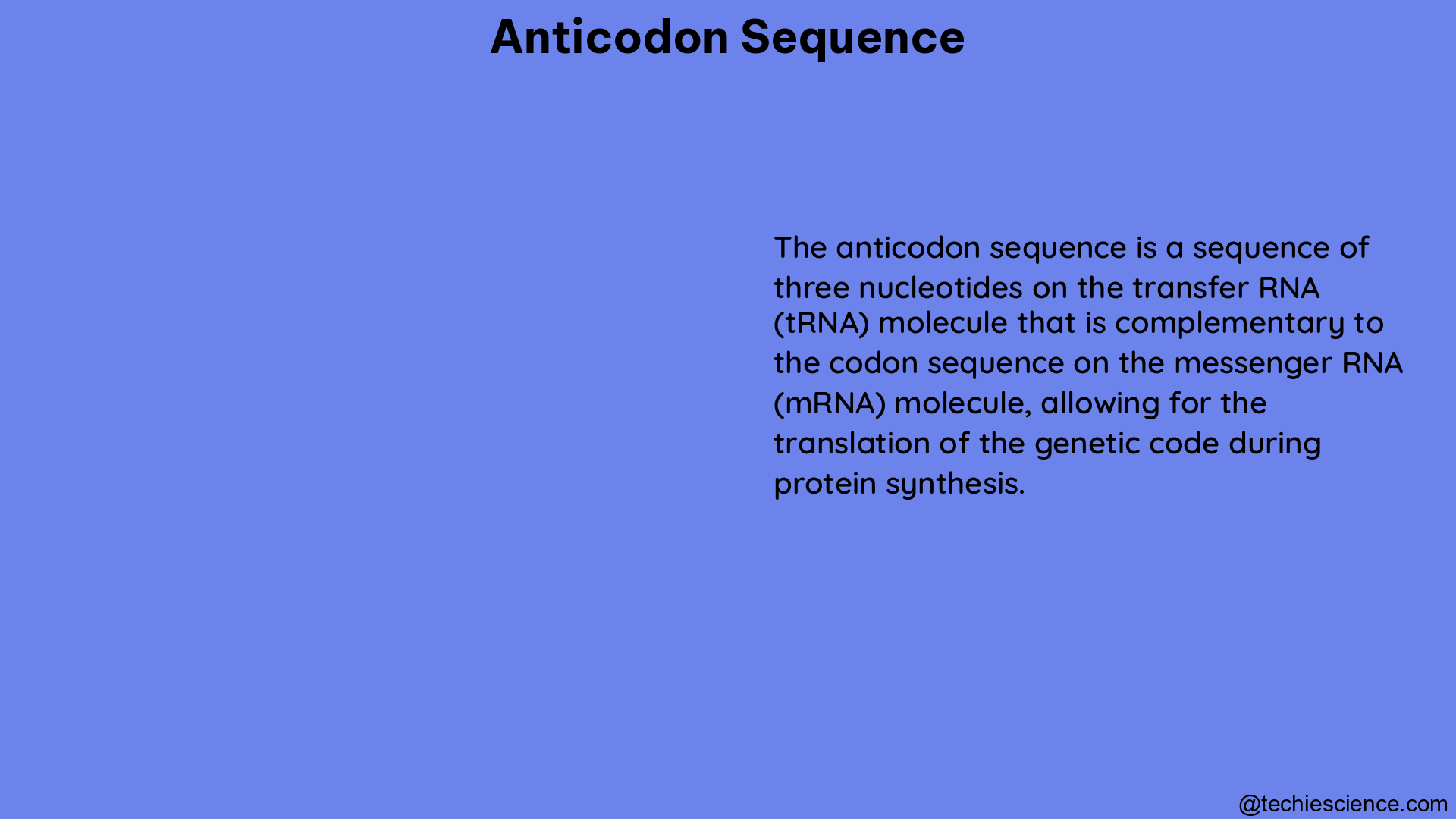The anticodon sequence is a fundamental component of transfer RNA (tRNA) molecules, playing a vital role in the process of protein synthesis within cells. This triplet of nucleotides binds to the corresponding codon on messenger RNA (mRNA) during translation, ensuring the correct amino acid is incorporated into the growing polypeptide chain.
Understanding the Anticodon Sequence
The anticodon sequence is located on the tRNA molecule and consists of three nucleotides that are complementary to the three-nucleotide codon on the mRNA. This complementary base pairing allows the tRNA to recognize and bind to the specific codon, thereby delivering the corresponding amino acid to the ribosome for incorporation into the polypeptide chain.
Anticodon Sequence Composition
The anticodon sequence can be composed of any combination of the four DNA/RNA nucleotides: adenine (A), guanine (G), cytosine (C), and thymine (T) or uracil (U). The specific sequence of the anticodon determines the amino acid that the tRNA will carry and deliver to the ribosome during translation.
Anticodon-Codon Interaction
The anticodon-codon interaction is a crucial step in the translation process. The anticodon sequence on the tRNA molecule must perfectly match the codon sequence on the mRNA for the correct amino acid to be added to the growing polypeptide chain. This precise base pairing ensures the fidelity of protein synthesis and prevents the incorporation of incorrect amino acids, which could lead to the production of non-functional or even harmful proteins.
Factors Influencing Anticodon Sequence Quantification

Accurate quantification of anticodon sequences is essential for understanding tRNA biology and its role in protein synthesis. However, several factors can impact the accuracy of anticodon sequence quantification, as highlighted in the studies by Zheng et al. (2024) and Zhang et al. (2023).
Quantification Approaches
Zheng et al. (2024) compared various quantification approaches for tRNA-Seq data, focusing on the anticodon and isodecoder levels. They found that the novel approaches, Decision and Salmon, consistently showed the lowest root mean square error (RMSE) and highest correlation, suggesting they handle multi-mapped reads most appropriately. In contrast, unique and MAPQ>10 methods performed poorly due to the discarding of multi-mapped reads, which can provide valuable information about the anticodon level.
Impact of Quantification Approach on Anticodon Quantification
The study also found that the choice of quantification approach can have different impacts on the quantification accuracy for each anticodon. For example, the correlation for Ser-GGA was much lower with Mimseq than Decision or Salmon, while the correlation for Pro-AGG was much higher with Mimseq than Decision or Salmon. This highlights the importance of considering the limits of each quantification approach when interpreting results for specific anticodons.
Anticodon Sequence Variants and Mistranslation
In the study by Zhang et al. (2023), the authors investigated the in vivo decoding specificities for mistranslating tRNA Ala anticodon variants. They found that variants with G, C, or U at position 34 (the first position of the anticodon) mistranslated the Watson-Crick cognate codon the most frequently, while variants with A34 mistranslated codons ending in C and U and to a lesser extent A, consistent with A34 being modified to inosine.
Impact of Anticodon Sequence on Translation Fidelity
The specificity of anticodon sequence variants in mistranslation is crucial for maintaining translation fidelity and preventing across-the-box mistranslation. The study highlighted the importance of the identity of tRNA base 34 in the anticodon sequence for ensuring accurate protein synthesis.
Anticodon Sequence and tRNA Stability
The study by Zhang et al. (2023) also found that the identity of tRNA base 34, the first position of the anticodon, can impact the growth and stability of tRNA molecules. Variants with U at position 34 had less impact on growth compared to their A, G, or C counterparts, while G or C at position 34 had the greatest impact on growth in each isodecoder set. This suggests that the anticodon sequence can influence the overall stability and functionality of tRNA molecules, which in turn can affect protein synthesis and cell growth.
Conclusion
The anticodon sequence is a crucial component of tRNA molecules that plays a vital role in the process of protein synthesis. Understanding the factors that influence the quantification and impact of anticodon sequences is essential for studying tRNA biology and its role in cellular processes. By considering the choice of quantification approach, the impact of anticodon sequence variants, and the influence of the anticodon sequence on tRNA stability, researchers can gain valuable insights into the complex mechanisms underlying protein synthesis and translation fidelity.
References:
- Zheng, Y., et al. (2024). Benchmarking tRNA-Seq quantification approaches by realistic simulations. eLife, 13, e96955.
- Zhang, Y., et al. (2023). Anticodon sequence determines the impact of mistranslating tRNA on translation fidelity and cell growth. Nucleic Acids Research, 51(5), 2825-2837.
- Li, B., et al. (2021). High-resolution quantitative profiling of tRNA abundance and modifications reveals insights into tRNA biology. Nucleic Acids Research, 49(7), 3761-3775.

Hello, I am Sugaprabha Prasath, a Postgraduate in the field of Microbiology. I am an active member of the Indian association of applied microbiology (IAAM). I have research experience in preclinical (Zebrafish), bacterial enzymology, and nanotechnology. I have published 2 research articles in an International journal and a few more are yet to be published, 2 sequences were submitted to NCBI-GENBANK. I am good at clearly explaining the concepts in biology at both basic and advanced levels. My area of specialization is biotechnology, microbiology, enzymology, molecular biology, and pharmacovigilance. Apart from academics, I love gardening and being with plants and animals.
My LinkedIn profile-